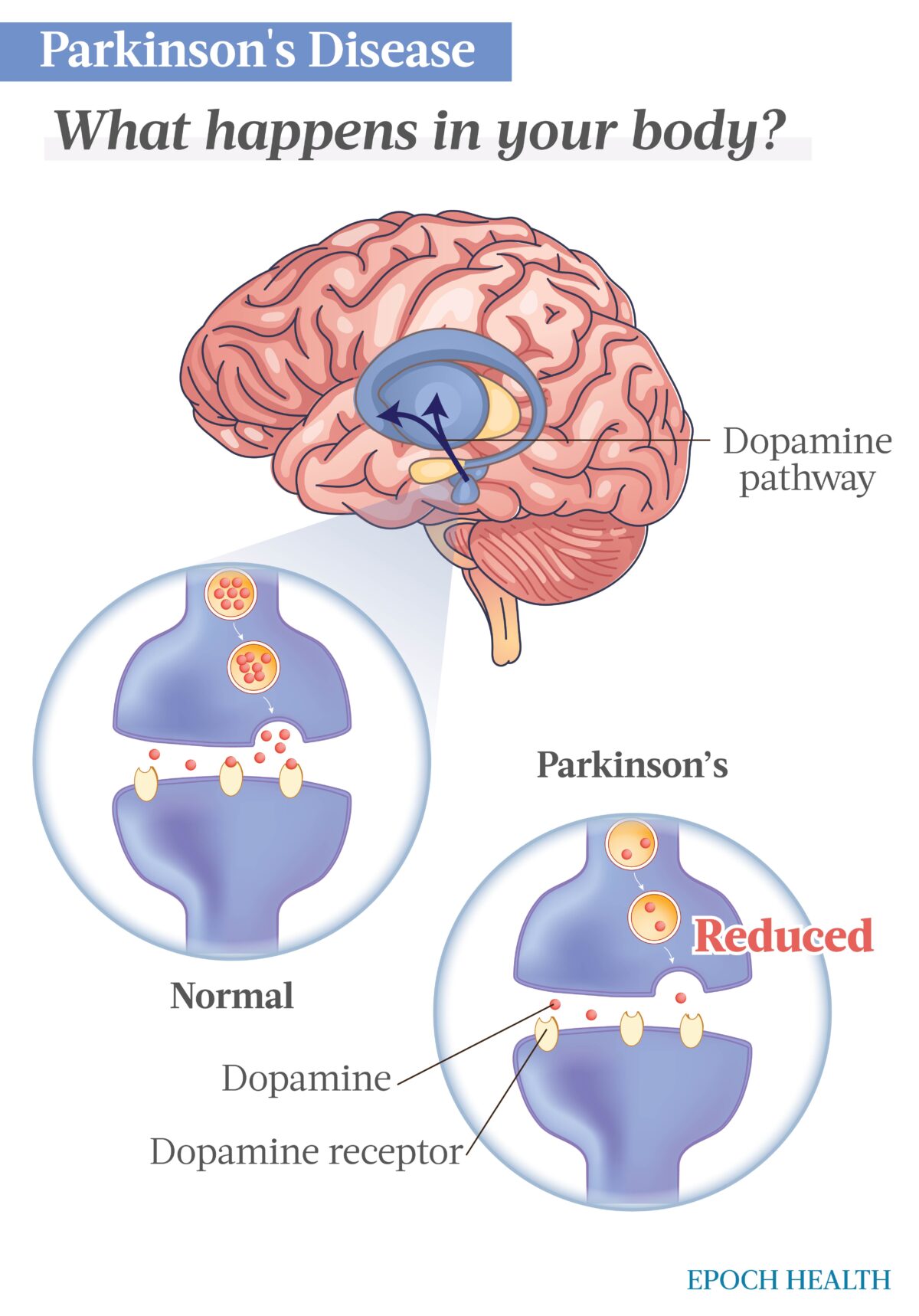By Stacy Swartz, The Epoch Times, April 16 2023
Parkinson’s disease affects about 1 million people in North America and over 10 million people around the globe. In the United States alone, Parkinson’s disease occurs in roughly 13 per 100,000 people with around 90,000 new cases detected each year, up from 60,000 in recent years, according to a 2022 Parkinson’s Foundation-backed study.
What Are the Common Types of Parkinson’s Disease?
Parkinson’s disease is a progressive disorder of the nervous system affecting regions of the brain that control balance and movement. Three main types characterize it:
Idiopathic Parkinson’s Disease
Idiopathic Parkinson’s disease is the most common type of Parkinson’s and its cause is generally unknown. A person afflicted with idiopathic Parkinson’s disease presents with bradykinesia along with rigidity, tremor, or both. These patients also present with more prominent symptoms on one side of the body than the other. This type affects older people.
Early Onset Parkinson’s Disease
Early onset Parkinson’s disease, also known as young-onset Parkinson’s disease, is a type that affects individuals under the age of 60, and generally between the ages of 21 and 50. This type of Parkinson’s is highly challenging and is often associated with psychological and social effects. Early onset Parkinson’s is linked to dystonia, a movement disorder that causes involuntary contractions of muscles, such as tremors, shaking, and ticks.
Inherited Parkinson’s Disease
Inherited Parkinson’s disease is linked to genetic inheritance meaning that the genes causing Parkinson’s are passed from generation to generation. This population accounts for approximately 10 to 15 percent of the Parkinson’s patient census. Scientists have found dozens of genes such as LRRK2, PARK7, and SNCA linked to the disease.
What Are the Symptoms and Early Signs of Parkinson’s Disease?
Symptoms start slowly and may be barely noticeable at first. For example, a person may experience tremors in just one hand. While tremors are typical in Parkinson’s disease, the disorder may cause stiffness and slowing of movement.
Your Health Matters
People affected by the early stages of Parkinson’s disease may show little or no expression on their faces. Their arms may not swing when they walk, or their speech may become slurred or soft. These symptoms will worsen as the disease progresses over time.
Signs and symptoms of Parkinson’s can be different for everyone. Although early signs may be mild or go unnoticed, symptoms generally begin on one side of the body and usually remain worse on that side, even when symptoms start to affect limbs on both sides.
Parkinson’s signs and symptoms can include:
- Tremor: A tremor is rhythmic shaking that usually begins in a limb, most commonly in the hand or fingers. Parkinson’s patients might rub their thumb and forefinger back and forth. This is called a pill-rolling tremor. They might notice their hand tremble when resting, but the shaking may decrease when performing tasks.
- Slowed movement (bradykinesia): Parkinson’s disease may progressively restrict a patient’s movement, making the simplest tasks difficult and time-consuming. One might drag or shuffle their feet, or notice their steps have become shorter when walking. They might also experience difficulty getting out of a chair.
- Rigid muscles: Stiffness may occur in the muscles throughout any part of the body. Muscle rigidity or stiffness can be painful and limit the range of motion.
- Impaired posture and balance: Posture in Parkinson’s disease patients may become stooped. Patients might also experience falls or have problems with balance.
- Loss of automatic movements: Parkinson’s patients may be unable to perform unconscious movements, including blinking, smiling, or swinging their arms when they walk.
- Speech and swallowing changes: Parkinson’s patients may speak softly, quickly, slur, or hesitate before talking. Speech could be monotone rather than having the usual speech patterns. In addition, patients may notice difficulty swallowing that typically starts with coughing while eating or taking longer to eat.
- Micrographia: Those suffering from Parkinson’s disease may notice that it’s hard to write, and their handwriting may appear small.
- Parkinsonian gait: Parkinsonian gait is characterized by a particular gait or walking pattern usually witnessed in later stages. This pattern is characterized by small shuffling steps that cause a reduced stride length. Patients walk in a stooped position at this stage with their head forward, shoulders down, and hips and knees bent. In addition, reduced swinging of the arms while walking, especially in the most prominent limb, is visible during this period.
What Causes Parkinson’s Disease?
Parkinson’s disease is a progressive illness caused by the degeneration, breakdown, or death of the brain’s neurons (nerve cells) that control movement.
Its most prominent symptoms are due to a loss of neurons that produce dopamine, a chemical messenger in your brain. A decrease in dopamine levels causes atypical brain activity, which leads to impaired movement and other symptoms associated with disease progression. Studies conclude that symptoms of Parkinson’s are evident in patients with an 80 percent or greater loss of dopamine-producing cells.
Dopamine usually operates in balance with other neurotransmitters to help coordinate millions of nerve and muscle cells engaged in movement. When dopamine is lacking, balance is disrupted, resulting in tremors, rigidity, slow movement, and impaired balance and coordination.

The cause of Parkinson’s disease is essentially unknown, but multiple factors appear to play a role.
Genes
Research conducted in 2005 discovered a single mutation in a Parkinson’s disease gene that is thought to be responsible for 5 percent of inherited cases. Scientists have identified specific genetic changes that may cause Parkinson’s disease. However, these genes are uncommon except in rare cases where many family members are affected by Parkinson’s. Certain gene variations appear to increase the risk of Parkinson’s disease with a relatively small risk for each of these genetic markers.
Scientists have studied and compared the DNA of those affected by Parkinson’s, discovering dozens of gene mutations associated with the disease.
While multiple genetic mutations have been associated with a higher risk of developing Parkinson’s, most people do not have these genetic variations.
Environmental Triggers
Exposure to toxins or environmental factors may increase the risk of Parkinson’s disease. The association between genes and the environment can be quite complicated. These risk factors include head injury, area of residence, and pesticide exposure.
While pesticides and head traumas are associated with Parkinson’s disease, most people do not have any obvious exposure to these environmental factors.
Researchers believe that many changes occur in the brains of people affected by Parkinson’s disease, although it’s not clear why these changes occur. Examples include:
- Presence of Lewy bodies: Lewy bodies are clumps of specific substances within brain cells that are microscopic markers of Parkinson’s disease. Researchers believe these Lewy bodies hold a significant clue to the cause of the disease.
- Alpha-synuclein found within Lewy bodies: While many substances have been identified within Lewy bodies, scientists believe a crucial one is a natural and widespread protein called alpha-synuclein. This protein is found in all Lewy bodies in a solid form that cells can’t break down. This is currently an important focus among researchers.

What Are the Stages of Parkinson’s Disease?
Parkinson’s disease is characterized by five stages.
Stage 1
This stage displays mild symptoms, and the disease does not interfere with daily activities. Mild changes in facial expressions, body posture, and walking may be present. Symptoms are usually contained to one side of the body. First-stage symptoms are so mild that others may not even notice unless pointed out.
Stage 2
Symptoms of stage 2 are moderate and visible to others. Symptoms are felt on both sides of the body. Normal daily activities can still be carried out but due to the progression in muscle stiffness, they may be more difficult to accomplish or take longer. Although balance is not impaired at this stage, posture change continues to progress.
Stage 3
Known as the middle stage, stage 3 includes balance impairment that might cause the affected person to begin experiencing falls. Movement at this stage becomes slower. Daily activities can still be performed, but they occur very slowly. Activities for daily living, such as bathing, dressing, and eating may become impaired.
Stage 4
At this stage, symptoms start to become severe. The person afflicted can no longer live independently because they cannot perform daily activities independently. The person affected can stand without support but cannot walk without an assistive device due to the frequency of their falls.
Stage 5
Stage 5 is the most advanced stage of Parkinson’s disease. Profound stiffness causes frequent falling and makes it difficult for the person to stand. During this stage, cognitive impairment is present and can be associated with other symptoms such as hallucinations, dementia, and sleep disturbances. A stage 5 person is also bedridden and requires a wheelchair for movement. Quality of life decreases.
Who Is More Likely to Get Parkinson’s Disease?
While Parkinson’s disease is considered to typically affect the older population, it is estimated that 1 in 10 people with Parkinson’s is diagnosed before age 50. The average age of onset is 60 years and older.
There are thought to be predispositions, risk factors, and conditions that lead to a higher probability of Parkinson’s.
- Parkinson’s affects both men and women but is 50 percent more prevalent in men than women.
- A person with a parent or sibling affiliated with Parkinson’s disease has approximately two times the chance of developing the disease.
- Exposure to chemicals such as herbicides and pesticides, or a Vietnam-era exposure to Agent Orange may increase risk.
- A person with a traumatic head injury or repeated injury to the head has a greater risk of developing Parkinson’s.
What Are the Tests for Parkinson’s Disease?
Parkinson’s disease cannot be diagnosed by a specific test. Instead, a neurologist, a specialized doctor specifically trained to treat nervous system disorders, will diagnose Parkinson’s based on each patient’s medical history and a review of their specific signs and symptoms by performing a neurological and physical examination. While imaging studies aren’t particularly helpful in diagnosing Parkinson’s disease, your provider may order the following:
- Single-photon emission computerized tomography (SPECT) scan: A SPECT scan is a nuclear imaging test that allows the doctor to study your body’s organs, tissues, and bones. It uses a radioactive substance and a specialized camera that creates 3D pictures.
- Dopamine transporter scan (DaTscan): This imaging test allows visualization of the dopamine system in the brain. This scan is similar to the MRI but studies the function of the brain rather than the structure. Although this study can support the diagnosis of Parkinson’s, most patients do not require the scan.
- Brain MRI: This painless imaging study produces clear images of the structure inside your head. Physicians use these to assess, diagnose, and monitor conditions affecting your brain or other internal head structures.
- Transcranial sonography (TCS): A TCS is a comparatively new ultrasound modality that displays the echogenicity of human brain tissue through the skull. This study helps differentiate between idiopathic Parkinson’s disease and other Parkinsonian disorders.
- PET scan: This is used to assess the function of the brain and activity in areas of the brain that involve movement.
It often takes time to diagnose Parkinson’s disease appropriately. Therefore, physicians may recommend routine follow-up appointments with a neurologist who will evaluate and follow your symptoms over time to diagnose Parkinson’s.
What Are the Complications of Parkinson’s Disease?
Parkinson’s disease is frequently associated with additional conditions or complications. However, some of these disorders may be treatable.
- Thinking difficulties: Parkinson’s patients may experience dementia, cognitive impairment, or thinking difficulties. These conditions generally occur in the later stages of the disease. A combination of medication and behavioral changes may help with cognitive impairment.
- Difficulty sleeping and sleep disorders: People with Parkinson’s frequently have difficulty sleeping and often wake up throughout the night. They wake up early and fall asleep during the day. Sleep apnea typically occurs in 40 percent of patients. Medications may improve sleep patterns.
- Emotional changes and depression: Many Parkinson’s patients experience depression. Receiving treatment for depression can make it easier to deal with the other challenges of the disease. Patients may also experience emotional changes such as loss of motivation, fear, and anxiety. These symptoms can be treated with medication.
- Chewing and eating problems: Parkinson’s disease in the late stages affects the muscles of the mouth, making it difficult to chew. Difficulty chewing can lead to choking.
- Swallowing problems: Difficulty swallowing may occur as the disease progresses and can result in poor nutrition. Saliva can build up in the mouth due to slowed swallowing, leading to drooling.
- Fatigue: Parkinson’s patients lose energy and tire easily, especially later in the day.
- Bladder problems: Parkinson’s may cause issues with the bladder such as difficulty urinating or being able to control urine. Studies suggest 30 to 40 percent of patients suffer urinary problems.
What Are the Treatments for Parkinson’s Disease?
Parkinson’s disease is not curable, but it is treatable. Medications are available that can help control symptoms and often improve quality of life. In some advanced cases, surgery may be recommended.
In addition to medicinal treatment, your physician may recommend lifestyle changes, especially physical exercise. Physical therapy that focuses on stretching and balance is essential in some patients. When speech problems are present, a speech-language pathologist may be used to help improve speech problems.
Medication
Medications that increase or act as a substitute for dopamine may be used to help you manage problems with movement, tremors, and walking.
Medications your doctor might consider include:
- Carbidopa-levodopa: This treatment replaces dopamine when it passes into your brain. Levodopa is combined with carbidopa, which protects levodopa from early conversion to dopamine outside your brain.
- Inhaled carbidopa-levodopa: This inhaled form of carbidopa-levodopa may help manage symptoms that arise when oral medications stop working during the day.
- Carbidopa-levodopa infusion: This is an infusion form of carbidopa-levodopa administered through a feeding tube, delivering the medication in a gel form directly to the small intestine. This medication is for patients with more advanced Parkinson’s disease.
- Dopamine agonists: Dopamine agonists mimic dopamine effects in your brain. Although dopamine agonists aren’t as effective as levodopa in treating symptoms, they last longer and may be used with levodopa to smooth the occasional off-and-on effect of levodopa.
- MAO-B inhibitors: These medications help prevent the breakdown of brain dopamine by hindering the brain enzyme monoamine oxidase B. This enzyme metabolizes brain dopamine.
- Catechol-O-methyltransferase (COMT) inhibitors: This medication prolongs the effect of levodopa therapy by blocking an enzyme that breaks down dopamine.
- Anticholinergics: These medications block the acetylcholine neurotransmitter and help control the tremor and other symptoms associated with Parkinson’s disease.
- Amantadine: This dopamine promoter temporarily relieves symptoms of mild, early-stage Parkinson’s disease. It may also be given with carbidopa-levodopa therapy during the later stages of Parkinson’s disease to control dyskinesia induced by carbidopa-levodopa.
- Adenosine receptor antagonists (A2A receptor antagonists): These are drugs that target areas that control the brain’s response to dopamine and allow more dopamine to be released.
- Pimavanserin: A drug used to treat hallucinations and delusions that people affected by Parkison’s disease may experience.
Surgery or Procedures
Deep brain stimulation (DBS) is generally offered to people with advanced Parkinson’s disease who have unstable medication (levodopa) responses. This treatment can reduce tremors, stabilize medication fluctuations, reduce or halt involuntary movements, reduce rigidity, and improve movements.
In DBS, electrodes are implanted into a specific part of the brain. The electrodes are connected to a generator implanted in the chest near the collarbone that sends electrical pulses to the brain, possibly reducing Parkinson’s disease symptoms.
Advanced Treatments
An MRI-guided focused ultrasound (MRgFUS) is a minimally invasive treatment that helps some Parkinson’s patients manage tremors. An MRI guides ultrasound to the area of the brain where the tremors initiate. The high-temperature ultrasound waves burn areas that are contributing to the tremors.
How Does Mindset Affect Parkinson’s Disease?
People living with Parkinson’s disease are affected by conditions, impairments, and pain that make day-to-day life challenging. These difficulties often impact physical, emotional, and mental well-being. However, a 2022 survey shows that attitude is a critical factor in the quality of life.
The Annual Parkinson’s Disease in America survey was conducted with more than 1,400 patients diagnosed with Parkinson’s disease. Seventy-five percent of respondents said their attitude was a critical factor in their quality of life, while 70 percent reported that they required some type of support, with emotional support being the top-ranked.
Those surveyed appeared to respond well to laughter. Fifty-one percent reported that they use humor and laughter as coping mechanisms. Almost 50 percent of respondents felt their faith or spirituality was a big part of how they stayed positive. Many shared that staying busy with activities helps them to remain in good spirits. They enjoy being involved in activities such as:
- Volunteering
- Crafting
- Reading
- Journaling
- Meditating
- Shopping
- Painting
- Spending time with friends and family
What Are the Natural Remedies for Parkinson’s Disease?
Although Parkinson’s is a progressive disorder, symptoms are generally managed with medication to delay progression and improve movement and functionality.
Over time, the medications and traditional drugs used to treat Parkinson’s symptoms may lose effectiveness. For this reason, it’s necessary to take additional steps to slow the progression of symptoms, preferably in the early stages of the disease. Numerous natural remedies have been identified that may help improve this critical condition.
Supplements
A balanced diet provides people with Parkinson’s disease with plenty of nutrients, vitamins, and minerals. However, researchers believe that augmenting a nutritious meal with specific supplements may help relieve some of the symptoms associated with this disease.
- Coenzyme (CoQ10): CoQ10 is a substance our bodies make that helps cells get energy from oxygen. While not all studies agree, some research suggests that taking high doses of CoQ10 may slow the progression of Parkinson’s disease in the early stages.
- Vitamins C and E: In one study, high doses of these antioxidant vitamins taken together lowered the risk of Parkinson’s up to 32 percent in individuals.
- Cytidinediphosphocholine, or CDP-choline: This is a substance made in the body that appears to increase dopamine levels. Mount Sinai indicates that one study showed that people who took 400 milligrams thrice daily could lower their levodopa dose.
- Phosphatidylserine (PS): PS is a substance made in the body that is essential to brain function. Parkinson’s disease patients often have low levels of PS. According to Mount Sinai, scientists found that taking 100 mg of PS three times per day improved mood and brain function in people with Parkinson’s disease and Alzheimer’s-type dementia.
- NADH: The active form of vitamin B3, nicotinamide adenine dinucleotide + hydrogen (NADH) helps increase dopamine biosynthesis. Studies on Parkinson’s disease have shown varied results; some have used injections rather than oral doses.
Massage
Massage can help to increase circulation and decrease muscle spasms. Cranio-sacral therapy, a massage therapy that focuses on the brain and spinal column, may reduce tremors and improve function.
Mind-Body Therapies
Tai chi, yoga, and qigong may improve balance, flexibility, and range of motion in people with Parkinson’s disease. These therapies may also boost mood and improve sleep.
Traditional Chinese Medicine and Acupuncture
Traditional Chinese medicine (TCM) considers disease as being caused by internal imbalances. Historically, Parkinson’s disease was treated with acupuncture and herbal remedies. Those affected by Parkinson’s disease may find that acupuncture helps improve sleep.
How Can I Prevent Parkinson’s Disease?
Although there is no identified way to prevent Parkinson’s disease, consuming a “brain-healthy” diet and including physical activity in your daily routine may help reduce the risk or delay the arrival of symptoms.
Research also suggests that certain diets or eating patterns may nourish your brain and may delay or stop Parkinson’s from exhibiting.
The Mediterranean Diet
The Mediterranean diet is rich in olive oil, fish, fruits, vegetables, and whole grains. It is linked with a decreased risk of Parkinson’s and delayed onset of symptoms.
Various antioxidants and anti-inflammatory components of the diet alter the brain so that the death of dopamine-producing nerve cells slows or stops.
The Mediterranean diet limits your consumption of dairy products, which are linked to an increased risk of Parkinson’s disease.
The essential components of the Mediterranean diet are consuming mainly plant-based foods such as fruits and vegetables, nuts, lentils, whole grains, legumes, peas, beans, and chickpeas. Limit red meat to a few times a week and consume a small amount of low-fat protein such as chicken, salmon, albacore tuna, or mackerel several times weekly.
Caffeine
Multiple studies have correlated caffeine consumption to a decreased risk of developing Parkinson’s disease.
Caffeine is considered neuroprotective, which means it protects the brain from damage from inflammation or a toxic chemical reaction called oxidative stress. Because both inflammation and oxidative stress are linked to triggering Parkinson’s, calming these factors may reduce dopamine nerve loss.
Exercise
Research has shown that moderate to vigorous physical exercise is associated with a lower risk of developing Parkinson’s.
Scientists believe that exercise reduces oxidative stress, inflammation, and the abnormal accumulation of alpha-synuclein protein in the brain. In Parkinson’s disease, alpha-synuclein forms toxic clumps called Lewy bodies within dopamine-producing nerve cells, which contribute to cell death.
Physical activity improves symptoms in patients with Parkinson’s disease. It has been known to improve the overall quality of life by slowing the disease process, decreasing the pain associated with Parkinson’s, prolonging independent mobility such as balance, gait, and strength, and improving memory, sleep, and mood.
Incorporate daily exercise to strengthen muscles. It helps to maintain flexibility, limit depression, and improve balance. Some patients develop an exercise plan with their physical therapist, while others engage in swimming, aerobic exercise, resisted active exercises, yoga, tai chi, etc.
When exercising, consider moderate to intense aerobic activities, including brisk walking, playing doubles tennis, bicycling slower than 10 miles per hour, or water aerobics.
Household chores such as vacuuming, gardening, mowing your lawn, or mopping the floor are moderately intense forms of physical activity.
Vigorous activities include jogging, swimming laps, hiking uphill, playing singles tennis, or bicycling faster than 10 miles per hour.
Stretching stiff muscles helps to improve balance and posture and relieve movement difficulties such as walking.
- Eat protein: Consuming protein helps prevent weight loss and muscle wasting. It facilitates wound healing and increases disease resistance, too. Eating a balanced diet is essential to avoid getting too much protein.
- Increase fiber: People affected by Parkinson’s disease have an increased risk of constipation. Increasing your intake of foods rich in fiber and vegetables helps to combat your risk of constipation.
- Perform gait training: Gait training helps improve balance by reducing the risk of falling and correcting the Parkinsonia gait pattern.





